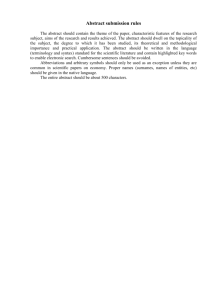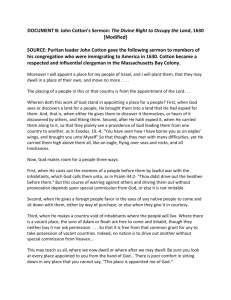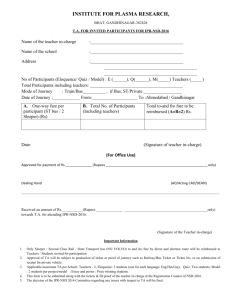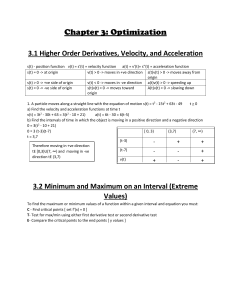Making Headways Smart Card Fare Payment and Bus Dwell Time in
advertisement
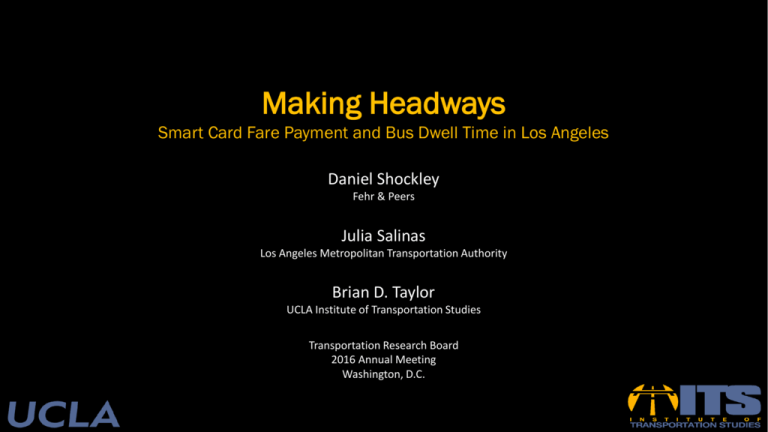
Making Headways Smart Card Fare Payment and Bus Dwell Time in Los Angeles Daniel Shockley Fehr & Peers Julia Salinas Los Angeles Metropolitan Transportation Authority Brian D. Taylor UCLA Institute of Transportation Studies Transportation Research Board 2016 Annual Meeting Washington, D.C. Agenda • Overview • Hypothesis • Methodology – Data Sources – Route Selection – Exclusions • Analysis – Variables – OLS Regression • Findings & Interpretation • Conclusions Overview: Los Angeles Metro Metro Rail 350,000 average weekday boardings Six lines (four light rail and two heavy rail) 80 Stations (26 under construction) 87 miles of track Five extensions currently under construction Overview: Los Angeles Metro Metro Bus Approx. one million average weekday boardings. Local Service: Frequent stops and infrequent headways. Rapid Service: Infrequent stops and frequent headways. Bus Rapid Transit: Two lines operating in exclusive right-of-way Overview: Transit Access Pass (TAP) Smart Card Fare Payment System Stored cash value or pass. Accepted at 24 transit systems in Los Angeles County. Required for Metro Rail. Dwell Time “the amount of time a transit vehicle spends at stops and stations serving passenger movements” Transit Capacity and Quality of Service Manual (TCQM) Dwell Time Bus Transit Route Capacity Bus Loading Area Clearance Time Bus Time Variability Bus Stops Failure Rate Bus Facilities Dwell Time Passenger Demand and Loading Bus Stop Spacing Fare Payment Procedures In-vehicle Circulation Research Question & Hypothesis Question: All other factors held constant, what is the influence of the TAP card on transit bus dwell times? Hypothesis: TAP card usage can help to reduce bus transit dwell time by reducing the amount of time to board per person. Method: Ordinary Least Squares (OLS) regression analysis with Dwell Time as the dependent variable, while controlling for as many other determinants of dwell time as possible using the data at hand. Why is this important? … lowers operating cost per route. … lowers headways per route. … reduces passenger waiting. … attracts more riders to faster service. Time saved per stop… Methodology: Sources APC - Automatic Passenger Counter – Alighting/boarding – Load factor – Dwell time – New data points for each stop. UFS – Universal Farebox System – TAP/Cash fare payments – Bicycle, wheelchair tallies, etc. – New data points for each fare paid/tally recorded. Methodology: Route Selection Metro Rapid 720 Infrequent stops, frequent headways. Avg. weekday ridership: 41,000 Avg. Saturday ridership: 29,000 Avg. Sunday ridership: 22,000 Serves many employment centers with connections to rail transit. Downtown LA Methodology: Route Selection Metro Local 120 Frequent stops, infrequent headways. Avg. weekday ridership: 4,000 Avg. Saturday ridership: 2,000 Avg. Sunday ridership: 2,000 Serves mostly residential and major physical rehabilitation center. Connection to Metro Rail. Methodology: Constructing the Data UFS Record 1 • TAP Fare payments APC Record UFS Record 2 UFS Record 3 • Bicycles, wheelchairs, etc. Constraints: • Operator-dependent tallies may not be accurate. • UFS and APC clocks may not be synchronized. • Non-TAP Fare payments Methodology: Exclusions • • • • Minimum Passenger Service Time (PST) < .5 second Dwell time is zero Stops at layovers, terminus, and time points. Abnormally long dwell time >= 180 seconds Route PST< .5s Dwell Time = 0s Layovers, etc. 720 120 6 2 3,361 454 14,472 4,838 Dwell Time ≥ 180s 2,477 104 Total 20,316 5,489 Grand Total 25,805 Methodology: Summary of Data 342 operators 187 vehicles 540,407 farebox records 99,453 APC records (N) Analysis: Descriptive Statistics Dwell Time (sec.) Passenger Service Time (sec.) Ons (#) Offs (#) Ons (no UFS) (#) Offs (Offs > Ons) (#) Dwell Load (#) TAP Fare (#) Non-TAP Fare (#) TAP (Sale of Value or Pass) (#) Wheelchairs (#) Bikes (#) Mean 26.7 7.3 3.4 3.6 0.7 2.1 22.9 2.2 0.7 0.0 0.0 0.0 Median 17.0 5.0 2.0 2.0 0.0 0.0 18.0 1.0 0.0 0.0 0.0 0.0 N = 99,453 Std. Deviation 25.6 11.1 4.8 4.8 1.6 3.8 19.0 3.6 1.6 0.2 0.1 0.1 Min. 1.0 0.0 0.0 0.0 0.0 0.0 0.0 0.0 0.0 0.0 0.0 0.0 Max. 180 180 52 65 44 65 107 59 31 5 3 3 Analysis – Controlling for other factors • Passenger Activity – – – – – Ons (no UFS) Offs (Offs > Ons) Dwell load Bikes and wheelchairs loading and unloading Abnormally long passenger boarding (>18s for one passenger) • Service & Vehicle Characteristics – – – – Peak hour service Night-time service Bus type (low/high floor/articulated/wide doors) Service type (rapid/local) Findings • People paying with TAP Cards take less time to board. • Articulated buses experience shorter dwells than nonarticulated buses. • Rapid routes had longer dwell time than local routes. Variable (Constant) Ons (no UFS) Offs (Offs > Ons) TAP Fare Non-TAP Fare TAP (Sale of SV or Pass) Fares in Grace Period Wheelchairs Bikes Dwell Load Peak Hour (1=Yes/0=No) Night Time (1=Yes/0=No) B 11.5* 3.8* 0.8* 2.7* 4.6* 9.0* -2.6* 36.9* 4.5* -0.01 -1.0* -2.1* Std. Error 2.8 0.0 0.0 0.0 0.0 0.3 0.1 0.6 0.7 0.0 0.1 0.1 Beta Articulated Bus (1=Yes/0=No) -3.3* Service Type (1=Rapid/0=Local) Wide Doors (1=Yes/0=No) Low Floor (1=Yes/0=No) Abnormal Boarding (1=Yes/0=No) 0.2 0.1 0.4 0.3 0.1 -0.1 0.2 0.0 0.0 0.0 0.0 T 4.1 100.2 46.4 130.1 100.7 29.0 -41.3 65.7 6.9 -1.9 -7.9 -15.6 Sig (p) 0.0 0.0 0.0 0.0 0.0 0.0 0.0 0.0 0.0 0.06 0.0 0.0 1.2 -0.1 -2.7 0.0 6.1* 1.2 0.1 5.0 0.0 0.4 1.0 0.8 2.9 0.0 0.0 0.5 0.3 0.6 0.7 24.0* 0.5 0.1 50.2 0.0 * Significant at the .001 Confidence Level Adjusted R-Square: .45 N = 99,453 Findings Passenger Congestion Variable (Constant) Ons (no UFS) Offs (Offs > Ons) TAP Fare Non-TAP Fare TAP (Sale of SV or Pass) Fares in Grace Period Wheelchairs Bikes Dwell Load Peak Hour (1=Yes/0=No) Night Time (1=Yes/0=No) Filtering the sample to records with a load factor of 1 or higher. • TAP fare payments take longer, however are still less than NonTAP. • Articulated busses reduce dwell time more than in prior Articulated Bus (1=Yes/0=No) model. Service Type (1=Rapid/0=Local) Wide Doors (1=Yes/0=No) Irregular Passenger (1=Yes/0=No) Low Floor B 9.0* 3.1* 1.0* 3.0* 4.0* 5.9* -1.7* 42.5* 1.8 0.04 0.3 -2.1* Std. Error 3.0 0.1 0.1 0.1 0.2 1.3 0.2 2.2 2.1 0.0 0.4 0.5 Beta 0.3 0.1 0.5 0.3 0.0 -0.1 0.2 0.0 0.0 0.0 0.0 T 3.0 32.2 15.3 48.2 26.3 4.5 -6.9 19.2 0.9 1.6 0.6 -4.4 Sig (p) 0.0 0.0 0.0 0.0 0.0 0.0 0.0 0.0 0.4 0.1 0.6 0.0 -11.9* 5.0 -0.1 -2.4 0.0 14.1* 4.3 0.1 3.3 0.0 0.4 3.8 0.0 0.1 0.9 15.8* 2.7 0.0 5.8 0.0 - * Significant at the .001 Confidence Level Adjusted R-Square: .49 N = 7,327 Conclusion 1. People paying with TAP contribute fewer seconds to dwell time, which can equate to large benefits later. 2. On a per-stop level, other factors seemed more important. 3. Technology can be improved to assist future analyses. Thank You! Contact: Daniel Shockley - d.shockley@fehrandpeers.com Photo Credits Metro local bus 2 - Jonathan Riley https://flic.kr/p/r4AEzy 720 - Oran Viriyincy https://flic.kr/p/qcdZ71 Metro Rail – Steve and Julie https://flic.kr/p/bDZRtC

